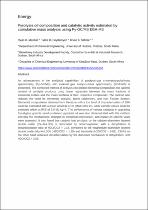 ResearchSpace
ResearchSpace
Pyrolysis oil composition and catalytic activity estimated by cumulative mass analysis using Py-GC/MS EGA-MS
JavaScript is disabled for your browser. Some features of this site may not work without it.
- ResearchSpace
- →
- Research Publications/Outputs
- →
- Journal Articles
- →
- View Item
| dc.contributor.author |
Merckel, RD

|
|
| dc.contributor.author |
Heydenrych, MD

|
|
| dc.contributor.author |
Sithole, Bishop B

|
|
| dc.date.accessioned | 2021-08-16T13:49:35Z | |
| dc.date.available | 2021-08-16T13:49:35Z | |
| dc.date.issued | 2021-03 | |
| dc.identifier.citation | Merckel, R., Heydenrych, M. & Sithole, B.B. 2021. Pyrolysis oil composition and catalytic activity estimated by cumulative mass analysis using Py-GC/MS EGA-MS. <i>Energy, 219.</i> http://hdl.handle.net/10204/12086 | en_ZA |
| dc.identifier.issn | 0360-5442 | |
| dc.identifier.issn | 1873-6785 | |
| dc.identifier.uri | https://doi.org/10.1016/j.energy.2020.119428 | |
| dc.identifier.uri | http://hdl.handle.net/10204/12086 | |
| dc.description.abstract | An advancement in the analytical capabilities of pyrolysis-gas chromatography/mass spectrometry (Py-GC/MS) with evolved gas analysis-mass spectrometry (EGA-MS) is presented. The combined method of analysis can predict elemental composition and calorific content of pyrolysis products using linear regression between the mass fractions of elemental entities and the mass fractions of their respective compounds. The method also reduces the need for elemental analysis, bomb calorimetry, and Karl Fischer titration. Elemental compositions obtained from literature with a low level of characterisation of 29% could be estimated with a mean absolute error (MAE) of 6.1%, while calorific values could be predicted within a MAE of 3.5 MJ kg−1. The performance of various catalysts in upgrading Eucalyptus grandis sawdust-derived pyrolysis oil was also demonstrated with this method, whereby the mechanisms, changes to elemental composition, and impact on calorific value were assessed. It was found that catalytic fast pyrolysis by the calcium-aluminium layered double oxide (Ca–Al-LDO) is dominated by decarboxylation, with a dehydration to decarboxylation ratio of H2O/CO2 = 0.18, compared to the magnesium-aluminium layered double oxide (Mg–Al-LDO) (H2O/CO2 = 1.29) and bentonite (H2O/CO2 = 0.82). ZSM-5 on the other hand achieved decarboxylation by the dominant mechanism of dehydration, with H2O/CO2 = 3.55. | en_US |
| dc.format | Abstract | en_US |
| dc.language.iso | en | en_US |
| dc.relation.uri | https://www.sciencedirect.com/science/article/pii/S0360544220325354 | en_US |
| dc.source | Energy, 219 | en_US |
| dc.subject | Catalysis | en_US |
| dc.subject | Fast pyrolysis | en_US |
| dc.subject | Pyrolysis-gas chromatography/mass spectrometry | en_US |
| dc.subject | Py-GC/MS | en_US |
| dc.title | Pyrolysis oil composition and catalytic activity estimated by cumulative mass analysis using Py-GC/MS EGA-MS | en_US |
| dc.type | Article | en_US |
| dc.description.pages | 15pp | en_US |
| dc.description.note | © 2020 Elsevier Ltd. All rights reserved. Due to copyright restrictions, the attached PDF file only contains the abstract of the full-text item. For access to the full-text item, please consult the publisher's website: https://www.sciencedirect.com/science/article/pii/S0360544220325354 | en_US |
| dc.description.cluster | Chemicals | en_US |
| dc.description.impactarea | Biorefinery Industry Developme | en_US |
| dc.identifier.apacitation | Merckel, R., Heydenrych, M., & Sithole, B. B. (2021). Pyrolysis oil composition and catalytic activity estimated by cumulative mass analysis using Py-GC/MS EGA-MS. <i>Energy, 219</i>, http://hdl.handle.net/10204/12086 | en_ZA |
| dc.identifier.chicagocitation | Merckel, RD, MD Heydenrych, and Bishop B Sithole "Pyrolysis oil composition and catalytic activity estimated by cumulative mass analysis using Py-GC/MS EGA-MS." <i>Energy, 219</i> (2021) http://hdl.handle.net/10204/12086 | en_ZA |
| dc.identifier.vancouvercitation | Merckel R, Heydenrych M, Sithole BB. Pyrolysis oil composition and catalytic activity estimated by cumulative mass analysis using Py-GC/MS EGA-MS. Energy, 219. 2021; http://hdl.handle.net/10204/12086. | en_ZA |
| dc.identifier.ris | TY - Article AU - Merckel, RD AU - Heydenrych, MD AU - Sithole, Bishop B AB - An advancement in the analytical capabilities of pyrolysis-gas chromatography/mass spectrometry (Py-GC/MS) with evolved gas analysis-mass spectrometry (EGA-MS) is presented. The combined method of analysis can predict elemental composition and calorific content of pyrolysis products using linear regression between the mass fractions of elemental entities and the mass fractions of their respective compounds. The method also reduces the need for elemental analysis, bomb calorimetry, and Karl Fischer titration. Elemental compositions obtained from literature with a low level of characterisation of 29% could be estimated with a mean absolute error (MAE) of 6.1%, while calorific values could be predicted within a MAE of 3.5 MJ kg−1. The performance of various catalysts in upgrading Eucalyptus grandis sawdust-derived pyrolysis oil was also demonstrated with this method, whereby the mechanisms, changes to elemental composition, and impact on calorific value were assessed. It was found that catalytic fast pyrolysis by the calcium-aluminium layered double oxide (Ca–Al-LDO) is dominated by decarboxylation, with a dehydration to decarboxylation ratio of H2O/CO2 = 0.18, compared to the magnesium-aluminium layered double oxide (Mg–Al-LDO) (H2O/CO2 = 1.29) and bentonite (H2O/CO2 = 0.82). ZSM-5 on the other hand achieved decarboxylation by the dominant mechanism of dehydration, with H2O/CO2 = 3.55. DA - 2021-03 DB - ResearchSpace DP - CSIR J1 - Energy, 219 KW - Catalysis KW - Fast pyrolysis KW - Pyrolysis-gas chromatography/mass spectrometry KW - Py-GC/MS LK - https://researchspace.csir.co.za PY - 2021 SM - 0360-5442 SM - 1873-6785 T1 - Pyrolysis oil composition and catalytic activity estimated by cumulative mass analysis using Py-GC/MS EGA-MS TI - Pyrolysis oil composition and catalytic activity estimated by cumulative mass analysis using Py-GC/MS EGA-MS UR - http://hdl.handle.net/10204/12086 ER - | en_ZA |
| dc.identifier.worklist | 24871 | en_US |





